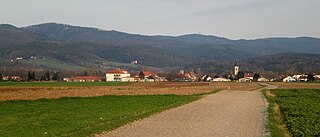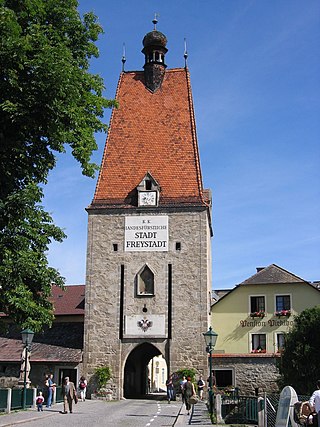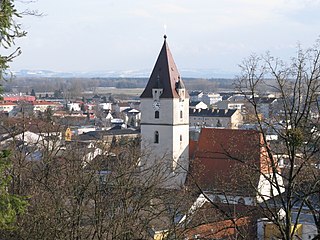
Lanzenkirchen is a market town in the district of Wiener Neustadt-Land in the Austrian state of Lower Austria.

Laxenburg is a market town in the district of Mödling, in the Austrian state of Lower Austria. Located about 20 km (12 mi) south of the Austrian capital Vienna, it is chiefly known for the Laxenburg castles, which, beside Schönbrunn, served as the most important summer retreat of the Habsburg monarchs.

Freistadt is a small Austrian town in the state of Upper Austria in the region Mühlviertel. With a population of approximately 7,500 residents, it is a trade centre for local villages. Freistadt is the economic centre of a district of the same name District Freistadt. The nearest sizeable cities are Linz, the capital of Upper Austria, about 40 km in the south, and České Budějovice, the capital of Southern Bohemia, about 60 km in the north.

Sankt Lambrecht is a market town in the district of Murau in Styria, Austria. It is known for St. Lambrecht's Abbey, one of the most important Benedictine monasteries in Austria. The monastery complex and its gardens are part of the Zirbitzkogel-Grebenzen nature park.

Kremsmünster is a town in Kirchdorf an der Krems District, in the Austrian state of Upper Austria. Settled in 777, it is home to the Kremsmünster Abbey.

Perg is a city in the Austrian state of Upper Austria, capital of the district of the same name.

Aldrans is a municipality in the Innsbruck-Land District, Tyrol (Austria) at an altitude of 760 m (2,490 ft), which had an area of 8.89 km2 (3.43 sq mi) and 2,496 inhabitants as January 2015.

Ossiach is a municipality in the Feldkirchen District in the Austrian state of Carinthia. The small settlement is mainly known for Ossiach Abbey.

Lambach is a market town in the Wels-Land district of the Austrian state of Upper Austria on the Ager and Traun Rivers. A major stop on the salt trade, it is the site of the Lambach Abbey, built around 1056. Notable alumnus from the local elementary school is Adolf Hitler, who attended the establishment in the 1890s.

Albeck is a municipality in the district of Feldkirchen in the Austrian state of Carinthia.
Sulz im Weinviertel is a town in the district of Gänserndorf in the Austrian state of Lower Austria. It is known for its open air museum in Niedersulz, the largest in Lower Austria.

Anras is a municipality in the district of Lienz in the Austrian state of Tyrol.

Stams is a municipality in Imst District, in the Austrian state of Tyrol. It is chiefly known for Cistercian Stams Abbey, founded in 1273 by Count Meinhard II of Gorizia-Tyrol and his wife.

Mattsee is a market town at the eponymous lake in the district of Salzburg-Umgebung in the Austrian state of Salzburg.

Dorfbeuern is a municipality in the district of Salzburg-Umgebung in the state of Salzburg in Austria.

Gosau is a municipality in the district of Gmunden in Upper Austria, Austria.

Wilhering is a municipality in the district Linz-Land in the Austrian state of Upper Austria.

Garsten is a municipality in the district of Steyr-Land in the Austrian state of Upper Austria.

Pietro Francesco Carlone, or Peter Franz Carlone, from the Leoben branch of the Carlone family, was an early Baroque architect who was best known for building abbeys.

Schlierbach Abbey is a Cistercian monastery in Schlierbach, Austria founded in 1355, and rebuilt in the last quarter of the 17th century. The original foundation was a convent for nuns, abandoned around 1556 during the Protestant Reformation. The abbey was reoccupied as a monastery in 1620, and rebuilt in magnificent baroque style between 1672 and 1712. The monastery again went into decline with the upheavals before, during and after the Napoleonic era. It recovered only towards the end of the 19th century. In the 20th century the abbey established a viable economy based on a glass works, school, cheese manufacturing and other enterprises. The abbey is open to visitors, who may take tours, attend workshops and dine at the monastery restaurant.





















